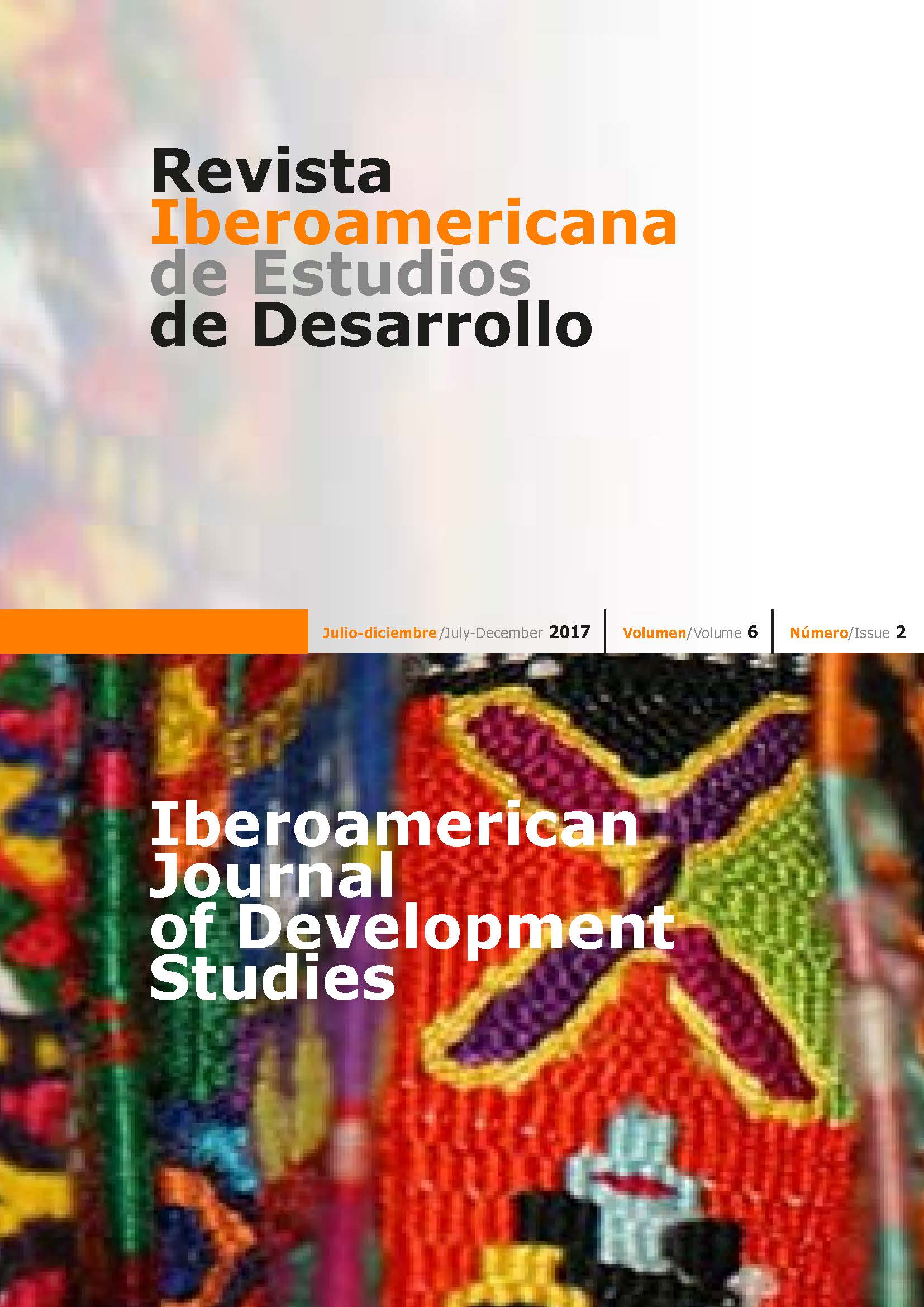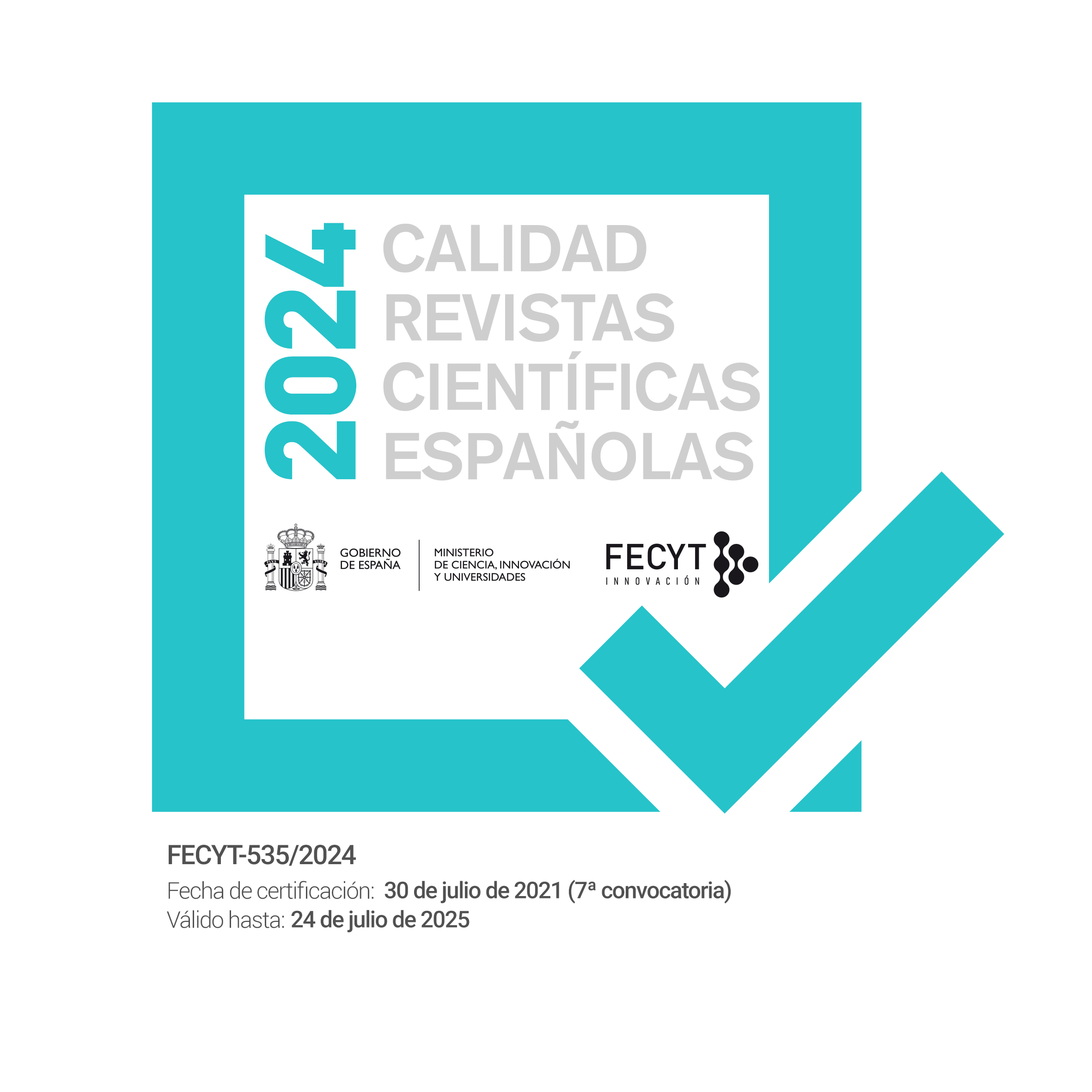Socio-economic factors determining the commitment to participate in an agricultural development project in rural Ethiopia
DOI:
https://doi.org/10.26754/ojs_ried/ijds.218Palabras clave:
agricultura, donación de pozos, compromisos socioeconómicos, proyectos de cooperación para el desarrolloResumen
Etiopía está sufriendo un éxodo masivo de población rural hacia la capital. Por lo tanto, el Gobierno trata de apoyar los proyectos realizados para estimular las oportunidades dadas al sector agrícola. En esta línea se ha diseñado un proyecto, en el cual se trabaja junto con una organización sin ánimo de lucro (ONG). En el presente trabajo de investigación se analizan los factores que determinan los compromisos socioeconómicos, educativos y nutricionales de los agricultores con el fin de diseñar un criterio de asignación en el marco de un proyecto de desarrollo rural en Etiopía, donde todas las familias han sido encuestadas. Los pozos donados se destinan a posibilitar su acceso a agua potable y a la creación de un huerto pequeño, con el objetivo final de mejorar su nivel de vida. Sin embargo, debido a que el número de pozos era limitado, resultó crucial identificar criterios de asignación para maximizar los resultados del proyecto. Las familias seleccionadas han de ayudar, asimismo, en la construcción de pozos adicionales para otras familias y mejorar así el estado social de la aldea mediante el compromiso de (i) devolver un porcentaje de los cultivos excedentes a la comunidad, (ii) ayudar a la formación continua en agricultura, contabilidad y nutrición y (iii) matricular a sus hijos en la escuela. Con el artículo se busca comprender qué variables sociodemográficas y económicas determinan los diferentes compromisos de las familias. Se realiza igualmente un análisis descriptivo de la muestra y se aplican diferentes técnicas multivariantes. Se observaron, de hecho, resultados interesantes, como un ingreso económico para las mujeres, la incorporación de un animal para el transporte o la posesión de un móvil, variables que determinan tales compromisos.
Descargas
Referencias
ABRO ZA, ALEMU BA, HANJRA MA (2014). Policies for agricultural productivity growth and poverty reduction in rural Ethiopia. World development 59(C):461-474.
ADJEI JK, ARUN T, HOSSAIN F (2009). The role of microfinance in asset-building and poverty reduction: The case of Sinapai Aba Trust of Ghana. BWPI Working Paper 87.
ADUSEI M (2012). Determinants of credit union savings in China. Journal of International Development 25:22-30.
AFRANE S (2002). Impact assessment of microfinance interventions in Ghana and South Africa: A synthesis of major impacts and lessons. Journal of Microfinance 40(1):37-58.
ALDERMAN H, HODDINOTT J, KINSEY B (2006). Long term consequences of early childhood malnutrition. Oxford Economic Papers 58(3):450-474.
ARMENDARIZ B, MORDUCH J (2010). The economics of microfinance. MIT, United States.
ASHRAF N, KARLAN D, YIN W (2006). Tying Odysseus to the mast: Evidence from a commitment savings product in the Philippines. Quarterly Journal of Economics 121(2):635-672.
BAHNG G (2013). Mitigating social exclusion in microlending: A case study of wisdom microfinance institution in Ethiopia. Journal of International Development 25:31-44.
BALI SR, VARGHESE A (2013). Delivery mechanisms and impact of microfinance training in Indian self-help groups. Journal of International Development 25:11-21.
BARNES C, GAILES G, KIBOMBO R (2001). The impact of three microfinance programs in Uganda. Washington DC: Management Systems International.
BELLON MR, GOTOR E, CARACCIOLO F (2015). Assessing the effectiveness of projects supporting on-farm conservation of native crops: Evidence from High Andes of South America. World Development 70:162-176.
BERNARD T, TAFFESSE AS (2014). Aspirations: An approach to measurement with validation using Ethiopian Data. Journal of African Economies 23(2):189-224.
BEZU S, HOLDEN S (2014). Demand for second-stage land certification in Ethiopia: Evidence from household panel data. Land Use Policy 41:193-205.
BEZU S, KASSIE JT, SHIFERAW B, RICKER-HILBERT J (2014). Impact of improved maize adoption on welfare of farm households in Malawi: A panel data analysis. World Development 59:120-131.
BOEHE DM, CRUZ LB (2013). Gender and microfinance performance: Why does the institutional context matter? World Development 47:121-135.
CIRAVEGNA D (2006). The Role of Microcredit in Modern Economy: The case of Italy. Flacso Working Paper. Costa Rica.
COLLINS D, MORDUCH J, RUTHERFORD S, RUTHVEN O (2009). Portfolios of the poor: How the world’s poor live on a $2 day. Princeton University Press.
DE BRAUW A, GILLIGAN DO, HODDINOTT JF, ROY S (2014). The impact of Bolsa Familia on schooling: Girl’s advantage increases and older children gain. International Policy Research Institute Discussion Paper 1319.
DE MEL S, MCKENZIE D, WOODRUFF C (2008). Returns to capital in microenterprises: Evidence form a field experiment. The Quarterly Journal of Economics 123(4):1329-1372.
DE MEL S, MCKENZIE D, WOODRUFF C (2009). Are women more credit constrained? Experimental evidence on gender and microenterprise returns. American Economic Journal: Applied Economics 1(3):1-32.
DE MEL S, MCKENZIE D, WOODRUFF C (2012). Enterprise recovery following natural disasters. Economic Journal, Royal Economic Society 122(59):64-91.
DE MEL S, MCKENZIE D, WOODRUFF C (2014). Business training and female enterprise start-up, growth, and dynamics: Experimental evidence from Sri Lanka. Journal of Development Economics 106(C):199-210.
DE MEZA D, WEBB DC (2001). Saving eliminates credit rationing. FMG Discussion Papers 391. Financial Markets Group.
DERCON S, HODDINOTT J, WOLDEHANNA T (2012). Growth and chronic poverty: Evidence from rural communities in Ethiopia. Journal of Development Studies 48(2):238-253.
DERESSA T, HASSAN RM, ALEMU T, YESUF M, RINGLER C (2008). Analyzing the determinants of farmers’ choice of adaptation methods and perceptions of climate change in the Nile Basin of Ethiopia. IFPRI Discussion Paper 00798.
DETHIER JJ, EFFENBERGER A (2012). Agriculture and development: A brief review of the literature. Economic Systems 36:175-205.
DOI Y, MCKENZIE D, ZIA B. (2014). Who you train matters: Identifying combined effects of financial education on migrant households. Journal of Development Economics 105:39-55.
DOOCY S, TEFFERA S, NORELL D, BURNHAM G (2005). Credit program outcomes: Coping capacity and nutritional status in the food insecure context of Ethiopia. Social Science and Medicine 60(10):2371-2382.
DUFLO E, GALE W, LIEBMAN J, ORSZAG P, SAEZ E (2006). Saving Incentives for low- and middle-income families: Evidence from a field experiment with Hand R block. Quarterly Journal of Economics 121(4):1311-1346.
FAFCHAMPS M, MCKENZIE D, QUINN S, WOODRUFF C (2014). When is capital enough to get female microenterprises growing? Evidence from a randomized experiment in Ghana. World Bank Working Paper.
GEORGE T (2014). Why crop yields in developing countries have not kept pace with advances in agronomy. Global Food Security 3:49-58.
GINE X, KARLAN DS (2014). Group versus individual liability: Short and long term evidence from Philippine microcredit lending groups. Journal of Development Economics 107:65-83.
HEEKS R (2010). Do information and communication technologies (ICTs) contribute to development? Journal of International Development 22:625-640.
HOLDEN ST, OTSUKA K (2014). The roles of land tenure reforms and land markets in the context of population growth and land use intensification in Africa. Food Policy 48:88-97.
HUSAIN Z, MUKHERJEE D, DUTTA M (2010). Self-help groups and empowerment of women: self- selection or actual benefits? Munich Personal RePEc Archive. MPRA No 20765.
JAYNE TS, CHAMBERLIN J, HAEDEY D (2014). Land pressures, the evolution of farming systems, and development strategies in Africa: A synthesis. Food Policy 48:1-17.
KARLAN D, APPEL J (2011). How a new economics is helping to solve global poverty. More than good intentions. Dutton, United States.
KARLAN D, ZINMAN J (2012). List of randomization for sensitive behaviour: An application for measuring use of loan proceeds. Journal of Development Economics, 98(1):71-75.
LACALLE CALDERÓN M, RICO GARRIDO S, DURÁN NAVARRO J (2008). Pilot impact evaluation of the Spanish Red Cross microcredit program in Ruanda. Revista de Economía Mundial 19:83-104 [in Spanish].
LAKWO A (2006). Microfinance, rural livehoods, and women’s empowerment in Uganda (African Studies Centre Research report 85). Ph. D. Thesis, submitted at the Radboud Universiteit, Nijmegen.
LUKE N, MUNSHI K (2011). Women as agents of change: Female income and mobility in India. Journal of Development Economics 94(1):1-17.
MADESTAM A (2014). Informal finance: A theory of moneylenders. Journal of Development Economics 107:157-174.
MANI S, HODDINOT J, STRAUSS J (2013). Determinants of Schooling: Empirical evidence from rural Ethiopia. Journal of African Economies 22(5):693-731.
MASON DR (2014). Who gets what? Determinants of loan size and credit rationing among microcredit borrowers: Evidence from Nicaragua. Journal of International Development 26:77-90.
MAYOUX L (1999). Questioning virtuous spirals: Microfinance and women’s empowerment in Africa. Journal of International Development 11:957-984.
MCINTOSH C, VILLARAN G, WYDICK B (2011). Microfinance and Home Improvement: Using Retrospective Panel Data to Measure Program Effects on Fundamental Events. World Development 39(6):922-937.
MCKENZIE D, WOODRUFF C (2008). Experimental evidence on returns to capital and access to finance in Mexico. World Bank Economic Review 22(3):457-482.
MINTEN B, STIFEL D, TAMRU S (2014). Structural transformation of cereal markets in Ethiopia. The Journal of Development Studies 50(5):611-629.
MOFED (2012). Ethiopia’s progress towards eradicating poverty: An interim report on poverty analysis study (2010/11). Addis Ababa, Ethiopia: Ministry of Finance and Economic Development.
MUTOKO MC, HEIN L, SHISANYA CA (2014). Farm diversity, resource use efficiency and sustainable land management in the Western highlands of Kenya. Journal of Rural Studies 36:108-120.
NYYSSÖLÄ M, PIRTTILÄ J, SANDSTRÖM S (2012). Helping Poor Farmers to Help Themselves. UNU-WIDER Working Paper 2012, 88.
OJO A, JANOWSKI T, AWOTWI J (2013). Enabling development through governance and mobile technology. Government Information Quaterly 30:32-45.
PELLEGRINA LD (2011). Microfinance and Investment: A comparison with bank and informal lending. World Development 39(6):882-897.
PLATTEAU J-P (2000). Allocating and enforcing property rights in land: Informal versus formal mechanisms in SubSaharan Africa. Nordic Journal of Political Economy 26:55-81.
RAHMAN A (1998). A micro-credit initiative for equitable and sustainable development. Who pays? World Development 26(1):67-82.
RAVI S (2014). Repay as you earn: loan repayment frequency, cash flows, and savings of households. Journal of International Development 26(4):438-453.
SAEZ E (2009). Details Matter: The impact and presentation of information in the take-up of financial incentives for retirement saving. American Economic Journal: Economic Policy 1(1):204-228.
SELLAMUTTU SS, AIDA T, KASAHARA R, SAWADA Y, WIJERATHNA D (2014). How access to irrigation influences poverty and livelihoods: A case study from Sri Lanka. The Journal of Development Studies 50(5):748-768.
SHIFERAW A, BEDI AS (2013). The Dynamics of Job Creation and Job Destruction in an African Economy: Evidence from Ethiopia from Ethiopia. Journal of African Economies 22(5):651-692.
SINGH A (2015). Land and water management planning for increasing farm income in irrigated dry areas. Land Use Policy 42:244-250.
SRABONI E, MALAPIT H, QUISUMBING AR, AHMED AU (2014). Women’s empowerment in agriculture: What role for food security in Bangladesh? World Development 61:11-52.
TURVEY CG, KONG R (2010). Informal lending amongst friends and relatives: Can microcredit compete in rural China. China Economic Review 21:544-556.
UNITED NATIONS (2015). Human Development Report 2015. New York: United Nations Development Programme. http://hdr.undp.org/sites/default/files/2015_human_development_report.pdf .
URQUÍA-GRANDE E, RUBIO-ALCOCER A (2015). Agricultural infrastructure donation performance: Empirical evidence in rural Ethiopia. Agricultural Water Management 158:245-254.
VALBUENA D, HOMANN-KEE S, ERENSTEIN O, TEUFEL N, DUNCAN A, ABDOULAYE T, SWAIN B, MEKONNEN K, GERMAINE I, GERARD B (2015). Identifying determinants, pressures and trade-offs of crop residue use in mixed smallholder farms in Sub-Saharan Africa and South Asia. Agricultural Systems 134:107-118.
VAN ROOYEN C, STEWART R, DE WET T (2012). The impact of Microfinance in Sub-Saharan Africa: A systematic review of the evidence. World Development 40(11):2249-2262.
WYDICK B, HAYES HK, KEMPF SH (2011). Social networks, neighbourhood effects and credit access: Evidence from rural Guatemala. World Development 39(6):974-982.
YOONG J, RABONOVITCH L, DIEPEVEEN S (2012). The impact of economic resource transfers to women versus men: a systematic review. Technical report, Social Science Research Unit, Institute of Education, University of London.
YUNUS M (1999). Banker to the poor. PublicAffairs, New York.
YUNUS M (2007). Creating a World without Poverty. PublicAffairs, New York.
Descargas
Publicado
Número
Sección
Licencia
Derechos de autor 2017 Elena Urquía-Grande, Cristina Del-Campo

Esta obra está bajo una licencia internacional Creative Commons Atribución-NoComercial-SinDerivadas 4.0.






